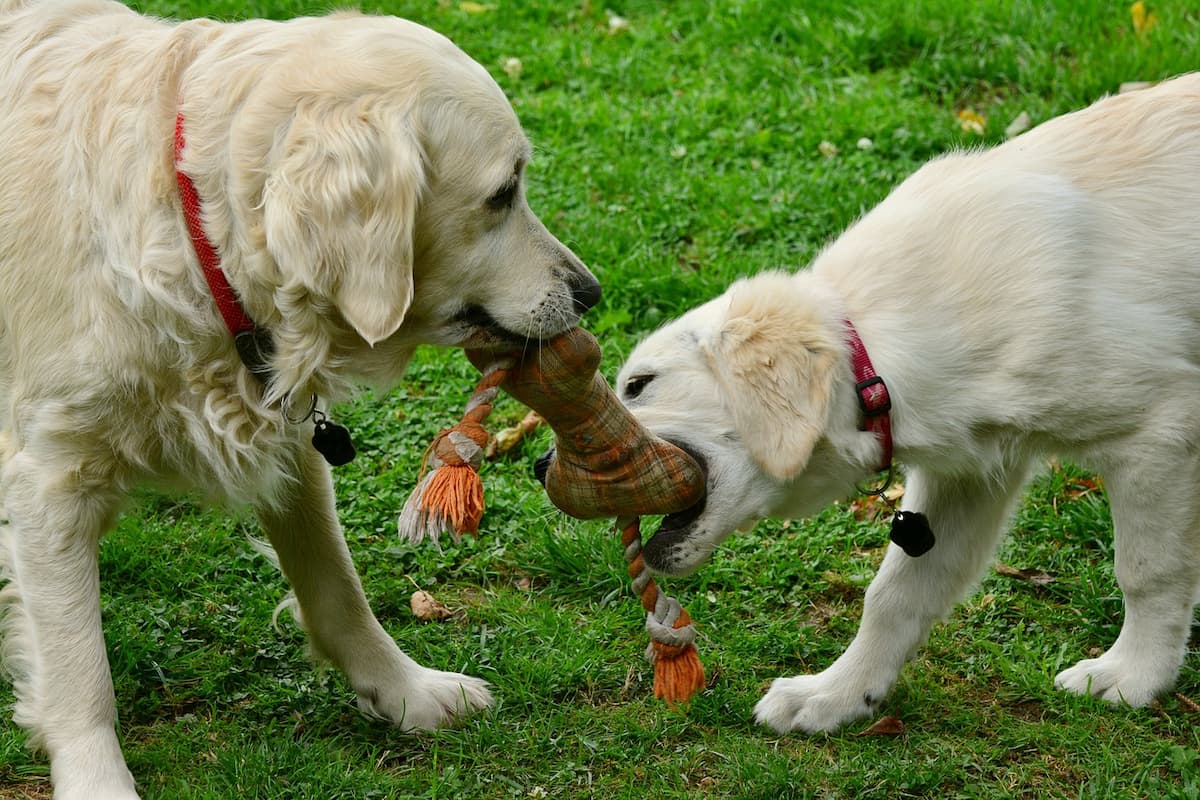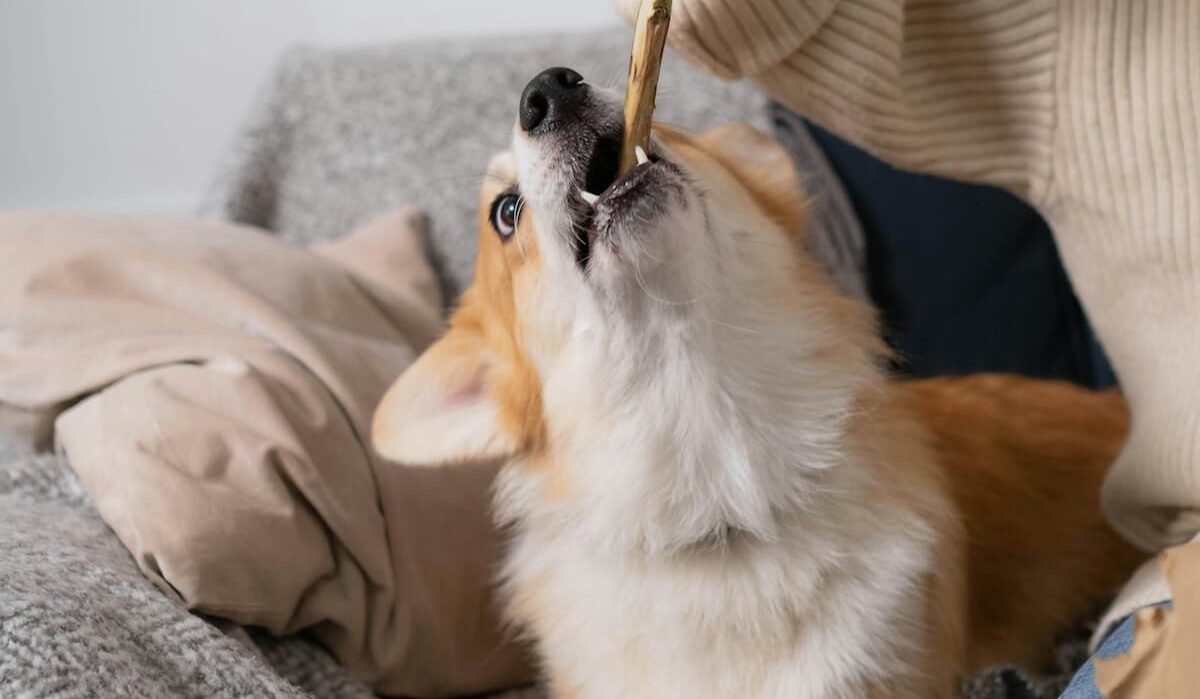Have you ever wondered why dogs seem to have an insatiable appetite for devouring everything in sight?
I mean, seriously, from socks to shoes, remote controls to flower petals, they’ll munch on just about anything they can sink their teeth into.
It’s like they have an invisible radar that detects the most enticing, often utterly bizarre, items for their next snacking adventure.
But why?
What drives our furry friends to become world-class chompers of all things weird and wonderful?
Read to find out.
Why Do Dogs Have a Compulsive Urge to Eat Everything in Sight?
Picture this: you’re out for a leisurely stroll with your furry friend when suddenly, they become fixated on something unappetizing lying on the ground.
It could be a discarded sandwich, a fallen apple, or even a leftover piece of pizza.
Without warning, your beloved canine devours it with unwavering enthusiasm.
But why do dogs have such an insatiable appetite for anything they find?
It turns out, there are several reasons behind this peculiar behavior.
One possible reason behind a dog’s eagerness to taste-test all things in sight is their natural instinct to explore the world through their senses.
Just like human babies put everything in their mouths to learn about different textures and tastes, dogs use their sense of taste to gather information about their surroundings.
Their highly sensitive noses allow them to detect subtle scents and flavors, making even the most mundane objects fascinating exploratory tools.
Another explanation for why dogs eat everything is their instinctual drive to scavenge for food.
In the wild, dogs and their ancestors relied on their scavenging abilities to survive.
This ancestral trait lingers in domesticated dogs, often compelling them to scavenge for food even when they have a well-balanced diet provided.
The act of compulsive eating could be a result of their strong survival instincts, causing them to seize any opportunity to fill their stomachs.
Why Dog’s Searching for Nutrients in Unexpected Places?
Another reason for why dogs eat everything in sight may lie in their unmet nutritional needs and their instinctual drive to seek out nutrients in unexpected places.
Like humans, dogs require a balanced diet to thrive and maintain optimal health.
When their nutritional needs aren’t being met, they may resort to seeking out alternative sources of nutrients.
This behavior is rooted in their ancestral instincts as scavengers, constantly searching for food in order to survive.
While your pup may have access to a well-balanced commercial dog food brand, their innate drive to seek out variety and different forms of sustenance can lead them to consume non-food items.
Furthermore, if your dogs’ diet is lacking in essential vitamins, minerals, or other vital components, they may instinctively seek out these nutrients in unexpected places.
This can manifest as grazing on grass, munching on dirt, or even devouring strange objects like rocks or plastic.
Dogs are incredibly intuitive when it comes to their own nutritional needs, and they may engage in these behaviors as a means of self-regulating their diet.
Boredom and Mental Stimulation’s Impact on Canine Munching
Dogs chewing on or eating random items can also be a result of boredom derived from a lack of mental stimulation.
When dogs become bored, they often resort to destructive chewing as a way to alleviate their frustration.
Imagine spending all day cooped up inside with nothing to do – it wouldn’t take long before you start searching for something to occupy your mind.
The same goes for our canine companions.
Chewing provides mental stimulation and can help alleviate stress or anxiety.
Without sufficient mental stimulation and exercise, dogs may turn to chewing as a way to entertain themselves and relieve their boredom.
Moreover, chewing can be a natural instinct for dogs.
It helps them explore the world around them and provides a sense of gratification.
Just like humans, dogs have an inherent need for mental and physical exercise.
When they don’t receive adequate stimulation, they may resort to chewing on objects to satisfy those instincts.
This can be particularly true for high-energy breeds who require regular exercise and mental challenges to keep them content.
Identifying Common Objects Dogs Find Irresistible
Here are some common objects that dogs find irresistibly tempting:
Chewing toys: We all know how much dogs love their chew toys, and it’s no surprise that they can easily mistake other objects for their beloved playthings.
From rubber balls to squeaky plush toys, anything with a texture that resembles their toys can spark their interest.
It’s important to provide them with appropriate chew toys to redirect their chewing behavior and prevent them from damaging valuable belongings.
Household hazards: Unfortunately, not all objects dogs gravitate towards are safe or suitable for chewing.
Some common household hazards include electrical cords, cleaning supplies, and household plants.
Dogs are curious by nature and may mistakenly think these items are toys or tasty treats.
Be vigilant in identifying potential hazards around your home and keep them out of your dog’s reach to ensure their safety.
Promoting Health and Safety through Prevention and Awareness
Pica, a condition where dogs compulsively eat non-food items, can be a cause for concern for pet owners.
Not only can it result in digestive issues and potential damage to their internal organs, but it can also pose serious safety risks.
From ingesting toxic substances to choking hazards, the dangers of pica shouldn’t be taken lightly.
Prevention plays a crucial role in ensuring our furry friends stay safe and healthy.
By understanding the reasons behind this behavior, we can take appropriate measures to address the root causes.
Boredom, anxiety, and nutritional deficiencies are common triggers for pica in dogs.
Ensuring they receive proper mental and physical stimulation, along with a well-balanced diet, can significantly reduce the likelihood of them turning to non-food items for satisfaction.
Regular exercise, engaging toys, and puzzle feeders can effectively keep their minds and bodies occupied.
Additionally, raising awareness about pica can go a long way in protecting our pets.
Educating ourselves and others about the dangers and signs of pica can help identify and address the issue early on.
Keeping our homes dog-proofed by removing any potential hazards, such as small objects, toxic plants, or household chemicals, is also crucial.
Regular veterinary check-ups can also aid in early detection and management of any underlying medical conditions that may contribute to the development of pica.
By promoting prevention and awareness, we can work towards creating a safer and healthier environment for our beloved canine companions.
Remember, identifying the underlying cause of your dog’s excessive eating habits is crucial in order to address the issue effectively and promote a healthier diet for your pup.
If your dog is feeling bored, always be sure to provide them with enough toys or activities to keep them mentally stimulated.
And if your worried that they may have an underlying problem, don’t be afriad to visit the vet.
FAQ
Q: What drives dogs to eat everything they encounter?
A: Well, our canine companions have an innate curiosity and a strong desire to investigate the world through their sense of taste.
Dogs are natural scavengers, stemming back to their distant ancestors who roamed the wilderness in search of food.
Q: Are there specific reasons why dogs have a tendency to eat things?
A: Absolutely!
Firstly, dogs have evolved to rely on their sense of taste to distinguish between edible and non-edible items.
Nevertheless, they don’t possess the same sophisticated discernment as humans do, which sometimes leads them to consume things that might seem bizarre to us.
Q: Can boredom be a factor behind a dog’s tendency to eat anything?
A: You hit the nail on the head!
Dogs are creatures of curiosity, and if they’re not mentally or physically stimulated, they may resort to eating random objects simply to alleviate their boredom.
Remember, a bored dog can be an inventive troublemaker!
Q: Could medical issues be at the root of a dog’s indiscriminate eating habits?
A: Absolutely.
On occasion, dogs may engage in pica, a behavior where they consume non-food items due to certain underlying medical conditions.
Nutritional deficiencies, gastrointestinal problems, and even stress can contribute to pica.
It’s essential to consult with a veterinarian if you suspect your furry friend may be struggling with a medical issue.
Q: How can we prevent dogs from munching on everything they find?
A: Ah, the million-dollar question!
Firstly, ensuring your pet has a well-balanced diet is crucial.
A proper diet reduces the chances of nutritional deficiencies that may trigger strange eating behaviors.
Additionally, providing plenty of mental and physical stimulation through toys, games, and exercise can help distract your dog from turning everyday objects into a snack.
Q: Are there any warning signs we should be aware of if our dog has ingested something harmful?
A: Definitely.
Keep an eye out for signs like vomiting, diarrhea, loss of appetite, lethargy, or distress.
If you suspect your dog has consumed something toxic or potentially dangerous, don’t hesitate to contact your veterinarian immediately.
It’s always better to be safe than sorry!
Q: Are there any dog breeds more prone to eating everything?
A: While all dogs are capable of developing odd eating habits, some breeds have a higher inclination towards this behavior.
Breeds such as Labrador Retrievers, Beagles, and Bulldogs are notorious for their hearty appetites and insatiable curiosity.
However, it’s important to remember that individual personalities and training play a substantial role in a dog’s behavior, regardless of breed tendencies.
Q: Can training help dogs overcome their compulsion to eat everything?
A: Absolutely!
Training and consistency are vital when it comes to correcting a dog’s eating habits.
Teaching the “leave it” and “drop it” commands can be immensely helpful in diverting your furry friend’s attention from potential hazards.
Positive reinforcement, rewards, and patience will go a long way in guiding them towards appropriate behaviors.
Q: Is there anything else we should concern about this eat everything habits?
A: Remember, our canine companions are driven by instincts and primal urges from their wild ancestors, so it’s no surprise they occasionally devour the unexpected.
By understanding their motivations, providing them with a well-balanced lifestyle, and staying attuned to their health and needs, we can foster a safe and happy environment for our furry friends.
Final Reflection
As it turns out, dogs have quite the appetite for exploration, driven by their natural instincts and curiosity.
Their sense of taste and smell is far more heightened than ours, making even the most repulsive things seem enticing to their discerning palates.
Whether it’s a juicy burger they’ve snatched from the countertop or a disgusting glob of unidentified mush found on the sidewalk, to them, it’s all just another tantalizing treat waiting to be devoured.
But let’s not forget that dogs are also known for their unendingly playful nature.
For them, chewing on random objects or swallowing them whole is a way to ease boredom, relieve stress, and even alleviate teething discomfort.
It’s like a canine version of thumb-sucking, providing comfort and entertainment when no one’s around to play fetch or give belly rubs.
Sometimes, though, our furry friends may engage in this voracious behavior due to nutritional deficiencies or underlying medical conditions.
Properly balanced diets and regular check-ups with the vet can help address these issues, ensuring that their insatiable appetites aren’t driven by a lack of essential nutrients.
So, the next time you catch your beloved pooch chowing down on something truly bizarre, remember that it’s all part of their natural canine charm.
Dogs live in the moment, following their instincts with a childlike wonder that we can only envy.
While we may never truly understand why our furry companions have such peculiar eating habits, we can appreciate their zest for life and their ability to find joy in the simplest of things.














